Have you ever noticed how “one size fits all” often means “one size poorly fits all”? This became especially clear to me when I started using a compression sleeve on my arm. Like any hacker, this seemed like something I could fix, so I gave it a shot. Boy, did I learn a lot in the process.
A little over a year ago, I started dropping things. If I was holding something in my left hand, chances were good that it would suddenly be on the ground. This phenomenon was soon accompanied by pain and numbness, particularly after banging on a keyboard all day.
At best, my pinky and ring fingers were tired all the time and felt half dead. At worst, pain radiated from my armpit all the way to my fingertips. It felt like my arm had been electrocuted. Long story short, I saw a neurologist or two, and several co-pays later I had a diagnosis: cubital tunnel syndrome.
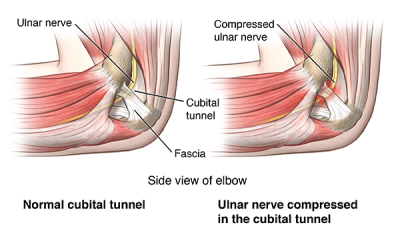
Tunnel of Pain
You’ve no doubt heard of carpal tunnel; this is its nasty cousin. My ulnar nerve was being compressed in my elbow, and the annoying discomfort made me want to gnaw my arm off.
I had surgery last summer to move the nerve to somewhere less pinchy. The shooting pain is gone now, and I’m beyond grateful for that. But my arm is still kind of messed up. Those two fingers still get tired almost every day.
Squeeze Play: My Short-Lived Store-Bought
I decided to try a compression sleeve for support. You know, those sausage casing things that athletes wear for increased blood flow and muscle recovery. I bought a cheap, no-frills sleeve from the drugstore that’s basically a tight tube of nylon/spandex with a thick band of elastic at the wide end. As soon as I put it on, my arm felt great. Energized, even. I could wear it most of the day and only feel a tiny bit fatigued.
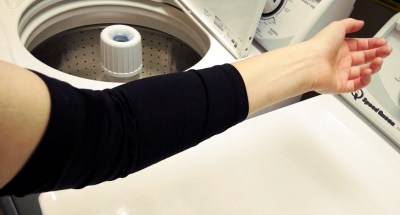
There’s just one problem: the fit keeps changing. After a day or so, the elastic band is stretched out, and I have to hike it up my arm every five minutes. I put it through the wash and it’d be snug again, but after just a few cycles, the elastic started to fray.
As soon as I fell in love with compression sleeves, I became dismayed at how flawed they are. It’s also disappointing that they only come in a couple of sizes.
So, I decided to try making my own, which I’m sure the Hackaday universe understands. I know these will lose shape, too, but if I can iterate until I lock in a pattern that’s tailor-made to my arm, I can have a bunch of sleeves around to wash/wear/coordinate with all my Steely Dan t-shirts.
How Hard Could Custom Tailoring Be?
I have some sewing experience, but none with fabric that’s weird or stretchy or particularly hard to work with. On the other hand, the design of compression sleeves is simple. Personally, I feel like most of the nerve-supporting compression happens in the elastic band, while the close-fitting sleeve provides muscle support and protection from dings. So I figure that if I can get the elastic to fit well, I’m halfway there.
There’s been a piece of stretchy, leopard-print fabric of unknown fiber content kicking around the house for a long time. It was a remnant that was too nice-feeling to leave in the bin. I decided to start with this stuff and see what happened. If it worked at all, I would go buy more remnants with high spandex content and keep iterating.
My plan was simple: just measure the store-bought sleeve and make it smaller! I cut out a rough rectangle, pinned down the seam on the forearm end, and tried to sew it with a straight stitch. My thread bunched up immediately, and the feed dogs—those little rows of metal teeth that grip the fabric and feed it along—weren’t having it. I tried a zig-zag stitch instead. It sort of worked, but the zigs and zags were so close together that it looked more like a liar’s polygraph than a resistor on a schematic.
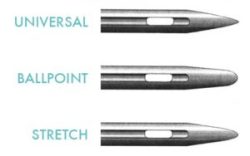
Specialized Tools for Working with Stretch Fabrics
Down but not out, I posed the question to le goog: how do I sew stretchy fabric? It returned a relevant YouTube video that taught me there is something called a stretch needle with a rounded tip.
This design lets the needle worm its way through the fabric rather than stabbing and hoping for the best. One short phone call to my local sewing machine company later, and I was on my way downtown to get a pack of five stretch needles for $5.
The same video clued me into stretch stitches. A line of regular, straight stitches has no stretch. But any zig-zag stitch will stretch naturally. Think of them like an accordion file or a scissor jack: they’re designed to expand. Many machines have one or more special, straight-look stretch stitches, but mine is fairly low-end.
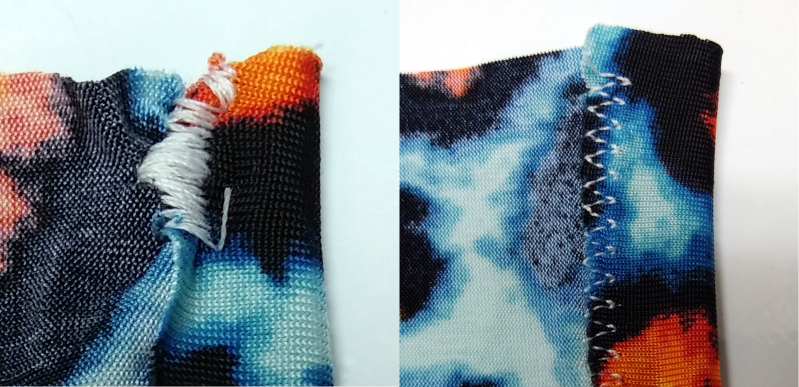
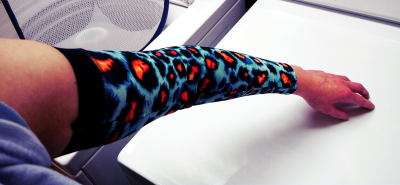 The Proof of Concept: Longer for Better Coverage, Sleeker to Hug the Taper
The Proof of Concept: Longer for Better Coverage, Sleeker to Hug the Taper
It was so much easier with the stretch needle that I just kept going until it was done. The fit wasn’t great, but it wasn’t terrible, either.
The elastic I bought is wider than the commercial sleeve, and I think that will lengthen the snug time before it starts getting loose. I also made it longer than the store-bought sleeve on purpose.
I got some new remnants from the fabric store including one that’s 82% nylon / 18% spandex. That’s 6% more spandex than the store-bought sleeve, which could be a bad thing. I figure, the higher the spandex content, the more room for error on my part. That is, it should be easier to iterate until I have a sleeve that’s snug, but not as tight as a blood pressure cuff.
I made this one a little differently. Instead of starting with a rectangle, I measured out an arc that corresponds to the taper of my arm, and then sewed along the pinned curve. I wanted to cut out a long trapezoid, but the piece was too small.
The second sleeve turned out great, but a bit loose, so I sewed another seam on the inside of the first one. Then I just cut off the extra material. This is where a serger would be great to have for a nice, flat seam because they cut the excess as they sew. But that doesn’t matter much, because I made a thing for a lot cheaper than I can buy it, and it’s tailored to me.
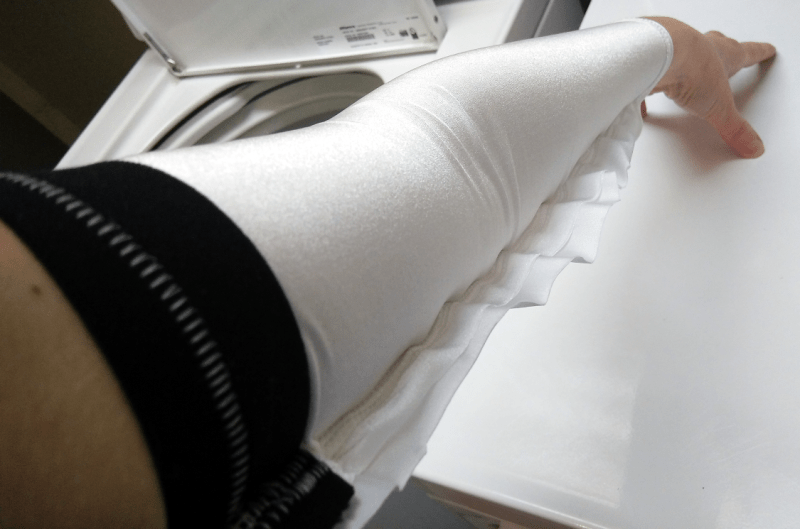
Eureka! The Return of Custom-Fit Garments
I thought this project would end up as Fail of the Week fodder, and it almost did. But after a little education, I was excited to try again and I ended up being more successful than I thought I would be. I’m going to make more and try some different things, like making a big hem instead of using elastic, or using a different color of spandex for visual appeal like a ringer t-shirt. Some sleeves have hard-shell protection over the elbow, which could be interesting to replicate with 3D printing.
The influence of globalization on costume is interesting. Back in the day, people had everything tailored and could rattle off their hat size, collar, and inseam without a thought. As fashion relaxed, populations increased, and women entered the workforce, we saw the rise of ready-to-wear clothing and ‘one size fits all’. When it doesn’t fit right, is like corner-cutting with a side of body shaming. But the skill and tools for custom tailoring are well within our reach.
So, Hackaday readers, what garment would you customize? Have you already done it? Let us know in the comments.

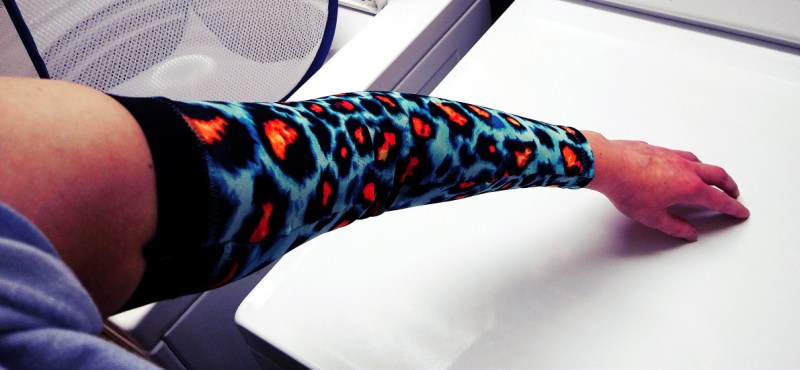














Excellent! I can’t help a sneaking liking for that garish leopard print. :)
And yes, stretchy fabric is annoying stuff to work with, isn’t it.
Are there even any good modeling software applications out there at all that handle it? I have seen a very small number of ultra expensive and still not very good commercial ones and that’s about it. Fitting a flat fabric onto somebody that is inherently 3D feels like a very poorly solved (mostly software) problem right now. At least in terms of released, available software. I have seen some promising research projects and things like that at least.
Also, if you had surgery to fix the problem, why didn’t it actually fix the problem? It sounds like it at least partially helped? If that’s the case, what else might be an issue and are there any other non surgical and non sleeve options now that you have had surgery that might also prove to be helpful? Unclear why this sleeve approach helps exactly although I do agree that one that fits correctly should be better than a generic one.
Cloth simulation isn’t trivial. CLO’s software is one of the market leaders (there’s a quite cheap “personal use” version called Marvelous Designer – which is the “go-to” tool for a lot of 3d-cloth problems).
You could instead use a modern 3d tool (like Houdini) and a 3d scan of your arm (which you can create using a cell phone) and create a perfect-fit wrap there (voxelize the arm, iso-surface a layer with an offset, UV-unwrap that along a seem – et voila: perfect-fit sewing plan).
Will take a look into some of the software options you mentioned, it’s been years since I last explored this in depth and the offerings were very, very limited back then as best as I was able to tell.
Are there fairly accurate cell phone 3d scanner apps out these days? Without a second lens, somewhat unclear how it is able to capture accurate depth information to create an accurate 3D image. Though some cell phones are starting to show up with stereo “vision”, which should be easy to stitch together.
In this case, the end product is a tube so a single seam or two would be all you would likely need here. Gets decidedly more complex if you are trying to make clothing for a person and I am curious how well that both works in practice but is able to be virtually modeled (different fabrics fall and move differently depending on the material, material thickness, location on the body, method of attachment, etc)
Get a marker or glittering konfetti. Sprinkle your arm.It will improve shape detection.Seriously.
Freckles and tattoos also work well.
For this purpose I would definitely prefer a non-permanent “tattoo” -> get the marker :-)
I was told it could take up to a year for the nerve to relax, so we’ll see after July 6th. Honestly, I should have pushed for more physical therapy before and after the surgery. I only went one time afterward, and he seemed pleased with my grip strength and such.
Right? I like it more each time I see it.
This project got me back into sewing in a big way. I think I’ll be buying a walking foot, which will help with everything including stretch!
I can recommend the investment in an entry-level overlocker/serger, you won’t regret it. Mine is mentioned here. https://hackaday.com/2017/05/23/the-textile-bench/
Neat article referenced also, thanks. I didn’t know what an overlocker was (I was using a lighter to smooth the frays) and wasn’t sure if the older non industrial Singers can handle the leather.
What thickness and tanning methods are you confident with using the Singer with?
I assume you use the knife blade looking needle for leather and I don’t recall what is in my box recommended thread.
I’ve seen a couple of sergers at 2nd hand stores (in the past 20 years or so) they were an early 1980’s Singer model and the 2nd hand price was around $15.
I recently picked up a free sewing machine I found on craigslist with a nice 16″ deep desk. Been salvaging free stuff lately (most items working too). Here’s the long drawn out video I made regarding that (and see 7:35 and later) and some other items (still stuck on truck restore work at the moment): https://www.youtube.com/watch?v=n0XMO2lWB5c
Wow! Nice job and a great write up. I had no idea about the different needles. I like how you sought out the answers to your questions and kept going!
Agreed!
I was aware of the universal and ballpoint needles (ballpoint was for polyester fabrics) so learning about a stretch point is good!
Thank you!
I am searching for answers to compression arm/leg sleeves. Thanks to your response and encouregment I will continue to find new ways to get compression wear for my arm/leg support. Loved your response and insight.
Way cool… pun intended. Awesome project! I love the poly lycra and stretchy materials. I haven’t found one yet that I am allergic too also which is a bonus. Coolmax got me hooked and the lightest I’ve found is ClimaLite by Adidas. I pretty much use as long underwear (including Buff neck gator and I have a balaclava for winter use as a liner) year round with white in the summer when outside working to substitute sunscreen, unless I want to get some sun. Interesting all the details for sewing and practicing to get correct. I like as a hot weather liner for sleeping on and in, like the cocoon sleeping bag liners. Thanks for sharing. I miss using a tailor, though enjoy when I can (except leather work needs an industrial machine or is way slow).
Actually, I miss my seamstress more.
Also, when I had carpal tunnel I used a bottle of Vitamin C with Strontium since Strontium is known to looses cartilage and joints to cause wrist joints, and I’d guess other joints, to grow in some cases. It’s called Reacta-C® [strontium calcium ascorbate with calcium threonate]. Seemed to work. Tennis elbow is another story.
Edit: Typo; “…looses…” should be “…loosens…”
Thanks… I was wondering what you meant by looses…
Right… yeah… I also wonder about arginine, citrulline or ornithine to encourage human growth hormone to also widen bones to help with nerve pain as an over the counter option also. Really need to be careful since can cause mental health issues potentially too kind of like roid rage. Oatmeal is a great source and quinoa too for balanced aminos so their isn’t a limiting amino nutrient issue also. My theory is sometimes for health issues (maybe our nerves grew too after bone fusion) we need to have a little growth spurt, then shrink again so not so mesomorph while accommodating the other tissues with less inflammation too.
When I didn’t know what was going on yet and wondered if I had rheumatoid arthritis or something, I tried vitamin D-3 for a minute. Didn’t really help with the joint pain, but I suppose that’s because it wasn’t really joint pain.
I have the XLHED and I’ve read there are Tumor Necrosis Factor (TNF) metabolisms that effect the inflammatory response. I’ve read the Vitamin D helps to counter the inflammation depending on say like Dr. Gundry diet recommendations with some Dr. Mercola latest interview regarding his supplement discussion. https://www.youtube.com/watch?v=9kTw7uG_9T0
Like Dr. Gundry notes and I can say first hand from Quality Control (QC) testing experience… the quality can vary in regards to testing of the raw materials, intermediates and finished products even if there is testing that is thorough due to source variations and there QC. I wonder which brands he advises? I haven’t read into enough yet and still think there is ES/TS EW ELINT operations causing inflammation also that came out with the Cuban U.S. Diplomat issues recently. Supplements and bio-equivalent medicine does work though the diagnostics in general can be improved for sure to determine optimal or at least effective therapy. Strange how athletes and anti-aging groups like performing artists have better resource and the rest get the negligence groups.
Thank you! Hmm, I’ll have to check out Coolmax and ClimaLite and see what materials they’re using.
I invested in a walking foot and was recommended from youtube videos and reading. Seems like a must have for certain materials unless you have some special sewing talents I know I don’t. :-)
“The influence of globalization on costume is interesting. Back in the day, people had everything tailored and could rattle off their hat size, collar, and inseam without a thought. As fashion relaxed, populations increased, and women entered the workforce, we saw the rise of ready-to-wear clothing and ‘one size fits all’. When it doesn’t fit right, is like corner-cutting with a side of body shaming. But the skill and tools for custom tailoring are well within our reach.”
In some ways like the whole 3D printing phenomenon. We have the technology. We have the materials. We still don’t have a massive rush because good-enough is cheap enough to not be worth the effort.
Rings cut from a suitable size old inner tube have many uses, as they retain their elasticity.
Thanks for letting me be curious, I learned about needles meant for stretchy fabric.
For carpal tunnel, if you haven’t been to a physiotherapist or the right physiotherapist yet: try a technique called ‘nerve flossing’. You can find instruction for simple relevant exercises on Youtube
If you feel you must share a ride to Manhattan by traversing the Holland tunnel, you may have Car Pool Tunnel Syndrome.
B^)
YES – I would have actually gnawed my arm off at some point if it weren’t for flossing exercises (and gabapentin).
This reminds me of trying to get compression stockings for my lower legs. Let’s just say that “one size fits all” means something more like “our one size doesn’t fit you, fatso.”
I’ve had a similar problem with commercially available knee pads for flooring or tiling sessions. No matter what the design, they never seem to fit well for very long — the calf and thigh straps always seems to migrate toward each other, bunching up together behind the knees. Quite painful. Wonder if something custom would help.
Custom fit is only part of it. Using less expensive materials generally tends to be correlated with poor fit and poor ergonomics as well. That said, the more expensive ones do not always actually fit or work better either. Compromises are also made in the design stage to make production easier or cheaper but that generally also mean the end product is less ideal as well. I think that’s a good bit of what you are running up against here.
The only knee pads I’ve ever found that were actually comfortable to use didn’t have straps, they fit into a pocket on the front of the knees on a sturdy pair of work pants or coveralls. (Random google search example: http://www.snickersworkwear.com/design-and-features/save-your-knees/how-to-pick-the-perfect-kneepad/)
The geometry of the leg around the knee just makes it pretty much impossible to strap something to that area and NOT have the straps end up right in the sensitive bits at the back of the joint.
Absolutely this. Double knee pants help a ton, and then throwing pads in makes working on your knees bearable. Another upside is most people won’t even know that you have knee pads on, so you can avoid the jokes.
FYI, Some of Duluth Trading Company’s pants have the knee pad pockets.
I end up only using the calf straps on my knee pads- they stay on well enough for walking and don’t pinch.
Sew belt loops to the back of your pants to run the kneepad straps through. Then they can’t move up or down.
Doh, I was thinking you meant sewing the loops up where the other belt loops were, instead of behind the knees/calves.
A lot of clothing tags now says “One size fits most”
I wear scrubs at work as do millions of others. These things are so simple, and generally fit poorly. I can’t see why they aren’t ordered to fit, then cut and stitched by robots and delivered to your door the next day. Hmmmm…
Kristina,
An interesting project.
If you are interested in delving deeper into the cause of this problem, and altering that, I may be able to help. Although medicine regards nerves as not stretchable (not ‘extensible’ is usually how this is described), the particular nerves you refer to (ulna and radial distribution of brachial plexus) must be able to be lengthened along their full course to enable many hand, arm, and shoulder movements. Modern life, involving much sitting, hunching, and concentrating, has altered the relationships of many of the involved tissues. For your problem (and carpel tunnel in some instances, and tennis elbow, when the problem is experienced on the other side of the elbow) adhesions between the structures you illustrate in the figure above are the culprit—once adhesions occur (and lack of regular full range of movement of the structures is this cause of this; fascia sticks if not moved), all the symptoms you describe, and more, may occur. Look up TOS, or TOCS (thoracic outlet syndrome, or compression syndrome, in the latter).
In all humans, the segmental nerves that emerge from the spinal cord in the neck come together to form brachial plexus, and emerge through the ‘thoracic outlet’ which is simply a space between the anterior and medial scalene—from there they pass under the tendon of pec. minor, then out along the arm. If one’s posture alters over time (typically the changes accompanying ageing) the body’s own structures can impinge on one or more of the nerves and/or adhesions occur at many points along the nerves’ passages, and the result can be the problems described.
I have many gentle stretching exercises on my YouTube channel that can help this; I will link to just one here:
https://www.youtube.com/watch?v=l8ko2hjOo_4
Try this very gently—I will forecast that you will not feel the effects of this in the neck itself, but generalised in the arm; this is a good start. Make sure you hold the ankle as described, and not with a thumb-opposed-the-fingers grip—you will not be able to traction the arm sufficiently (insufficient grip strength). Try once or twice gently, and only twice a week in the beginning. Wearing your compression sleeve during this process will help, too.
I have been trying to hack the body’s functions and problems for 30+ years now, and we are starting to understand it. In general, it is the change from a great deal of daily life movement and manual work to a more sedentary lifestyle (sitting to work, and driving rather than walking) that have led to a rash of new problems for everyone. In other words, it is what we are not doing that is the basis cause of a huge fraction of modern problems.
There are ways of measuring for custom made garments that account for the contour of different parts of the arm. Incorrect measurements could lead to areas of higher compression (measured in milligrams of Mercury) and if you have a nerve injury it’s best to keep this in mind. Seams can also cause places of higher tension and garment manufacturers are supposed to be mindful of the kinds of bands put on the end of garments so they do not cause a tourniquet effect. This is something else to be mindful of during experimenting with making garments. I definitely agree there are problems with off the shelf garments and think it’s cool you are experimenting but it is risky particularly as you seem to have some numbness and may not be able to feel if the garment is causing circulation issues. Good Luck!
“Here at home we’ll play in the city
Powered by the sun
Perfect weather for a streamlined world
There’ll be spandex jackets one for everyone”
;-)
:D
FWIW, there is now an open source garment design app called Seamly2d which will allow you to create clothing patterns from scratch.
How very cool, thanks for letting us know :-)
Does it do Lederhosen?
B^)
What happens in the sewing room stays in the sewing room…
Whoa! Thanks for the tip!
I wonder if a network of bands 3d printed out of flexible material would work better, kind of like the casts that they make now that look like alien cocoons. Might have to use a dissolvable scaffolding…and put a fabric liner inside…
Or maybe better yet, print the flexible filament directly into the fabric before stitching it together…idk, just tossing out ideas.
Nicely written article btw.
When I read the titlle, this is the type of compression sleeve that came to mind. https://www.nicopress.com/products/compression-products
Funny you post this – I just bought a sewing machine and have been teaching myself how to sew? I made pillows with custom fabric that had my face printed on it (long story) as gifts over the weekend and am moving on to tool rolls and ditty bags now. Hope to alter some linen shirts I have soon.
The fun part about sewing (not unlike microcontroller programming or other hacking) is that your problems are never unique and whatever you’re trying to do there’s a methodology to it. Likewise it’s fun taking things apart and realizing the process behind, say, your jeans.
I fell a moment when seam rippers come in handy to make patterns.
Kristina,
I just found your website by chance (was looking at Maslow CNC Router which I also found by chance).
You may already know this and as you had surgery it may not matter but it wouldn’t hurt to look into it. About 10 years ago I was hit by semi and on disability for 2 years. During that time I was on PC much more (nothing else to do) and I developed similar symptoms you describe.
toward the end of it was seeing a chiropractor and one day I mentioned to him I think I had carpel tunnel but not really. He laughed and said why. “well when I am on the pc my pinky starts to hurt tingle and or go numb, but I know the carpel tunnel is not ‘here’
He laughed again and while never named the issue he described it. “You are right its not carple tunnel, but there is a nerve that goes from here (neck area) all the way down your arm (traced it) to your pinky
He worked a little more on the neck that day and very little if none at all on the hand or elbow… So if you have ever been to a chiro.. there work doesn’t last long the first time… it doesn’t work much at all… until it does. So he was already working on my neck and continued and over a few weeks – it went completely away, despite my next 3 jobs requiring computer work.
I don’t know if this will help you but it did me and I would feel bad not saying anything as I can see it helping with the side effects you still have – adjusting my neck actually helped my pinky and I never had to have surgery – Oddly it just started bothering me again today – been over 10 years – and so is my neck which never stopped – guess I need to go see chiro again myself.
Jim
I definitely have neck issues of some kind. The first doctor I saw suggested cervical radiculitis. While I’m personally conflicted on chiropractors, I’m glad they help you.
I understand “personally conflicted on chiropractors”… I went to one once that seemed more interested in draining my health account than telling me I had a pulled muscle.
Maybe you can find one that is recommended by friends, or consider an osteopath, basically they are chiropractors with a medical degree.
What Ren say about a D.O. is good advise… Also I have been to 3 really good ones in my life and they all had something in common. They were all 2nd generation chiropractors and loved what they did. I asked the one, Adam “so how long you been a chiro”. – he said 36 years and laughed … I said huh ? you aren’t old enough … and then he said well really 12, but my dad is a chiropractor and I grew up with it so it SEEMS a lot longer.
Believe it or not massage therapy helps too – I laughed at it the first time the doctor said it so I was admittedly skeptical, but still open (i know it sounds contradictory – but its not) .
Its like a soft version of chiro.. and I watched the video of the ‘stretch guru’ above and I think he is really on to something.
Hope feel/ get better –
Jim
Hardly a guru! Just someone who has been sieging the problem set of how to be comfortable in the human body for 30+ years. Back pain was my PhD research area for many years, along with relevant logic.
We put these videos out on YouTube because, like Hackaday, we have an explicitly open learning system. This is where the internet is at its best, IMHO.
A good chiropractor will work on loosening up your muscles first, so they don’t pull the correction back out of place. I once saw a chiro who didn’t and my back went back out within five minutes of leaving his office!
I started getting this issue after getting a new job at an office. So I got a new chair that was higher so I didn’t lean on my elbows while typing. I stopped having numbness and tingling from compression in my elbow. Maybe you need a new chair and need to stop leaning on your elbow while bending your wrists.
I don’t mean to belittle you but I had no insurance and had to look into this cause I was in regular pain for more than a month. All I had to do was get a better chair and change my posture. I don’t think we should use technology to make it easier to do things we should not do, like making bad posture easier to accomplish.
I had issues before with my leg, after breaking it and having the plates put into my my leg fail. I had them removed because they were cracked, I refused to have more put in as I felt it would keep failing. I was told I would need a cane and would never be able to run or ride a bike. I can do both now by exercising more and maintaining good posture. I have not used a cane since having my plates removed.
I almost lost movement in my leg 3 years after having my plates removed. This was due to muscle loss even while having an active job involving lots of walking and carrying heavy objects. It was so bad I could not physically put my own socks on by myself. This was all due to posture and pacing my work load. This was at a job that involved miles of walking and racking 4U servers by myself on a daily basis.
Please remember your body is a very advanced machine and exercise and posture will take you farther than making a fancy cructch if you can get away with not having one.
This is the really wonderful article you shared here. Sometimes, we couldn’t stretch as much as we want. These sleeves are the best compression accessories that help us to recover our muscles faster than other cloth accessories. You can wear them during playing games/sports and in leisure time. Thanks for sharing. I must bookmark your articles.
Hi, I actually work for a medical compression company, making the custom patterns for clients. Gloves, sleeves, tights and more. You basic design is pretty good.
White print on a purple background is easier to read and less strenuous on the eyes.
I love that fabric! Where did you find it? I want to make these exact compression sleeves!
I’m interested in this sort of thing to try and make my own custom compression stockings since I can never find ones that are large in the correct places and smaller in other places not to mention being long enough for my crazy long legs, and the elastic on top is almost always between either slicing my leg open or me needing a garter belt to hold them up.
Something custom sounds perfect, and doing it myself sounds better since my insurance wont cover customs.
Hi
I sometimes make my own outdoor and camping gear so thought I might mention a few things that might be of use :
First off you can buy-online outdoor and technical fabrics ranging from what they make rucksacks out of to gossamer thin silnylon, and everything in between, like velcro, padding and webbing for straps.
Just google ‘MYOG outdoor and technical fabrics cordura silnylon’ for a range of options and websites with hints and tips.
Second, elastic dies if you max it out, so just double it up, maybe with weaker elastic, and it will last longer :
Technically, if the ‘load’ put on it *exceeds* the max it can bear without breaking down, it will stop being elastic in behaviour.
Just think of a heavy weight on a thin thread, snap !
So the trick is in the old saying : Many hands make light work :)
So just use more than one thread, and keep adding threads until the weight gets divided up so much that the weight on each thread is nowhere near the max it can take.
It’s how they make suspension bridges !
So if you double or triple up your elastic material ‘units’ ( or more ! ) then the ‘load’ on each duplicate piece will be halved or cut in three so the load on each individual piece of fabric won’t overload that individual piece of elastic at all and if you use enough ‘units’ of elastic fabric it should last forever ;)
So for example if you use a slightly weaker elastic but double or triple it up, it shouldn’t squeeze too much but should stay strong a lot longer !
.. you might want to make each outer layer a little longer so that the final outside layer isn’t just taking all the strain and leaving the inner layers slack.
Have fun :)
I always think handmade is difficult. But your post encourgaes me. I may have a try later.
Thank you for this post. You have inspired me to try a medical garment sewing project. I am working on an upper thigh to just below the knee compression garment for my swollen left lymphedema leg [cancer treatment related]. There is a well known brand I am trying to imitate with this velcro wraps legging scheme. Their garments cost over $300, yikes. Commercial products are usually made with fabric I am allergic to and cannot seem to fit my measurements. They also tend to have design flaws that a make quick potty breaks wet-your-pants difficult!
I am using a free legging pattern from Patterns for Pirates, cut off 6″ below the knee. Lapped wrap arounds made of 3″ wide velcro will compress as needed and can be adjusted. This will be a one leg item, with a waistband. One velcro round below the knee and 4 velcro rounds up to the inner thigh crease. The velcro is sewn to an under lining of sheeting [or quilting fabric scraps] with zig caged edges to reduce fraying. I have a Berninia Sewing machine from the late 1980’s with great stretch stitches that I used to use to make swimsuits. I use a calf sleeve below the knee [Doc Miller makes some that do not make me break out in a rash]. I will publish on my old, rarely used blog if I succeed.